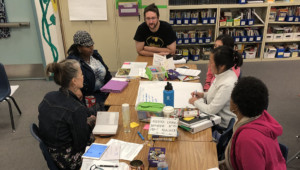Competency-Based Micro-credentials are Transforming Professional Learning


We’re going to need every ounce of ingenuity, imagination, and creativity to confront…problems Sir Ken Robinson
The world is changing, and — as Sir Ken Robinson professes — we will need every ounce of capacity we can find and create.
One of the keys to unlocking creativity, ingenuity and much more is taking new approach to professional learning. In a world where new forms of contribution are valued, learning opportunities ought to also shift be more personalized, practical, applied and nimble.
What if we had a system where professionals were able to learn what they need to learn, were able to learn what they wanted to learn and could show what they know? I imagine we would progress further and faster.
We need an approach to learning that meets people where they are rather than simply sorting learners into “people who are done earning degrees” and “those who are about to start earning a degree.” Long-form advanced degree programs can take several years and, while they still have an important role, there should be other options that can more directly impact professional learning (and therefore student learning) NOW — not just “down the road.”
According to Digital Promise, effective professional learning is:
- Personalized and self-directed
- Focused on the needs of educators, students and schools
- Competency based, and
- Job embedded and practical
Micro-credentials meet those criteria and more. A micro-credential is a certification indicating demonstrated competency in a specific skill. Micro-credentials are also on-demand, shareable, and personalized. Learners have voice and choice in what credentials they want to pursue and can create their own education playlists.
At the 2017 iNACOL Symposium, we hosted a pre-conference workshop focused on micro-credentials. While the focus was on those for professional educators, the practice is widespread across industries. For example, Digital Promise is working with Facebook to offer micro-credentials that will close a digital skills gap.
It’s a Show What You Know World
To put micro-credentials in a broader context, it is important to note that they go hand-in-hand with a competency-based approach, as learners of all ages advance to higher levels of learning when they demonstrate mastery of concepts and skills regardless of time, place or pace.
According to a report on the future of competency-based education (a collaborative report published by iNACOL in partnership with CompetencyWorks and several other leading partners) the following are true of competency-based systems:
- Learners advance upon demonstrated mastery
- Competencies include explicit, measurable, transferable learning objectives that empower students
- Assessment is meaningful and a positive learning experience
- Learners receive timely and differentiated support
- Learners develop and apply a broad set of skills and dispositions
In a competency-based approach to professional learning, learners choose an area of focus, choose how to learn, and demonstrate mastery. The result? Educators earn micro-credentials for showing what they know.
The movement is growing, as 21 states have approved all of Digital Promise’s micro-credentials, meaning that educators can utilize micro-credentials to earn continuing education units that will apply towards re-certification.

What Are Micro-Credentials?
As stated, micro-credentials are a digital certification indicating demonstrated competency in a specific skill. They promote learning by doing: educators apply their learnings in their practice, collect evidence, and demonstrate their competence.
As outlined in a paper Micro-credentials: Driving Teacher Learning & Leadership (co-produced by Digital Promise and the Center for Teacher Quality), here are some defining features of micro-credentials:

To operationalize the micro-credentialing process, Digital Promise has teamed up with Bloomboard. This brief Bloomboard video brings to life the role and goal of micro-credentials in education context:
Design and Combine in Stacks
While Digital Promise and Bloomboard have designed numerous micro-credentials together, they have also partnered with organizations such as the Friday Institute, Relay GSE, Future Ready Schools and others to develop micro-credentials.
For a sneak peek at current micro-credentials offered, see Bloomboard’s micro-credential home.
As you will see, micro-credentials can be “stacked” – or combined to achieve mastery in a larger concept. For example, these are all part of a Learning Differences stack.

Two core questions go into the design process for micro-credentials:
- What do you want learners to be able to know or do as a result of completing the micro-credential?
- What evidence can they provide you that they know or are able to do it?
For those who want to design micro-credentials, Alex Dreier of Friday Institute advises,“Keep it simple and focus on the core questions.”
Getting Started and Learning More
Whether you are interested in earning a micro-credential, designing a micro-credential or utilizing micro-credentials as part of a competency-based approach with students, there are numerous resources available.
Here are several related articles and resources:
- Micro-credential Offerings (Bloomboard)
- Taming The Wild West Of Digital Badges And Credentials (Forbes)
- Rethinking High School Graduation Requirements: Project & Microcredentials (Getting Smart)
- Students Earn Digital Badges for Project Management Skills (Getting Smart)
- MakerEd Micro-Credentialing: Teachers Want to Play Too! (Getting Smart)
- Recognition for MCs: Symposium on the Currency of Micro-credentials (Digital Promise)
- Teachers Customize Professional Development Through Microcredentials (EdWeek)
- What Do Teachers Want from Their Professional Development? (Digital Promise)
- Symposium on the Currency of Micro-credentials (Council of Chief State School Officers, Learning Forward and Digital Promise)
Further, strong implementation efforts are taking place in many districts across the country, including Harmony Public Schools (Texas), Chautauqua Lake Schools (New York), Dysart Unified (Arizona), Kettle Moraine School District (Wisconsin). Several state departments of education, including Florida and Arkansas are entering into partnerships.
it’s time to make way for micro-credentials — the future of professional learning. There is nothing micro about how competency-based credentials have the potential to change the professional learning game on a MACRO-level.
Have you experience in competency-based professional learning, earned a micro-credential or have resources to share? Leave as a comment below.
Read More:



John Sutherland
Nice article, Mary. I enjoyed reading it and feel that it is being more applied in medical teaching and learning than ever before, particularly in procedural skills. Keep up the good work.
Juan Cristóbal
Muy bien explicado. Felicitaciones.